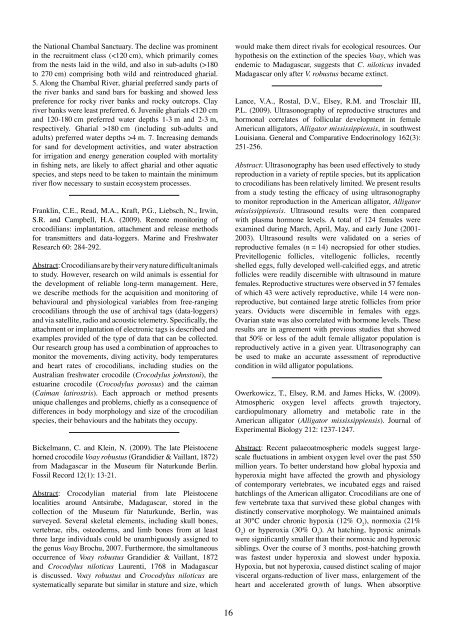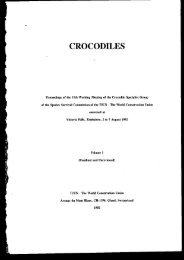CROCODILE SPECIALIST GROUP NEWSLETTER
CROCODILE SPECIALIST GROUP NEWSLETTER
CROCODILE SPECIALIST GROUP NEWSLETTER
Create successful ePaper yourself
Turn your PDF publications into a flip-book with our unique Google optimized e-Paper software.
the National Chambal Sanctuary. The decline was prominent<br />
in the recruitment class (180<br />
to 270 cm) comprising both wild and reintroduced gharial.<br />
5. Along the Chambal River, gharial preferred sandy parts of<br />
the river banks and sand bars for basking and showed less<br />
preference for rocky river banks and rocky outcrops. Clay<br />
river banks were least preferred. 6. Juvenile gharials 180 cm (including sub-adults and<br />
adults) preferred water depths >4 m. 7. Increasing demands<br />
for sand for development activities, and water abstraction<br />
for irrigation and energy generation coupled with mortality<br />
in fishing nets, are likely to affect gharial and other aquatic<br />
species, and steps need to be taken to maintain the minimum<br />
river flow necessary to sustain ecosystem processes.<br />
Franklin, C.E., Read, M.A., Kraft, P.G., Liebsch, N., Irwin,<br />
S.R. and Campbell, H.A. (2009). Remote monitoring of<br />
crocodilians: implantation, attachment and release methods<br />
for transmitters and data-loggers. Marine and Freshwater<br />
Research 60: 284-292.<br />
Abstract: Crocodilians are by their very nature difficult animals<br />
to study. However, research on wild animals is essential for<br />
the development of reliable long-term management. Here,<br />
we describe methods for the acquisition and monitoring of<br />
behavioural and physiological variables from free-ranging<br />
crocodilians through the use of archival tags (data-loggers)<br />
and via satellite, radio and acoustic telemetry. Specifically, the<br />
attachment or implantation of electronic tags is described and<br />
examples provided of the type of data that can be collected.<br />
Our research group has used a combination of approaches to<br />
monitor the movements, diving activity, body temperatures<br />
and heart rates of crocodilians, including studies on the<br />
Australian freshwater crocodile (Crocodylus johnstoni), the<br />
estuarine crocodile (Crocodylus porosus) and the caiman<br />
(Caiman latirostris). Each approach or method presents<br />
unique challenges and problems, chiefly as a consequence of<br />
differences in body morphology and size of the crocodilian<br />
species, their behaviours and the habitats they occupy.<br />
Bickelmann, C. and Klein, N. (2009). The late Pleistocene<br />
horned crocodile Voay robustus (Grandidier & Vaillant, 1872)<br />
from Madagascar in the Museum für Naturkunde Berlin.<br />
Fossil Record 12(1): 13-21.<br />
Abstract: Crocodylian material from late Pleistocene<br />
localities around Antsirabe, Madagascar, stored in the<br />
collection of the Museum für Naturkunde, Berlin, was<br />
surveyed. Several skeletal elements, including skull bones,<br />
vertebrae, ribs, osteoderms, and limb bones from at least<br />
three large individuals could be unambiguously assigned to<br />
the genus Voay Brochu, 2007. Furthermore, the simultaneous<br />
occurrence of Voay robustus Grandidier & Vaillant, 1872<br />
and Crocodylus niloticus Laurenti, 1768 in Madagascar<br />
is discussed. Voay robustus and Crocodylus niloticus are<br />
systematically separate but similar in stature and size, which<br />
would make them direct rivals for ecological resources. Our<br />
hypothesis on the extinction of the species Voay, which was<br />
endemic to Madagascar, suggests that C. niloticus invaded<br />
Madagascar only after V. robustus became extinct.<br />
Lance, V.A., Rostal, D.V., Elsey, R.M. and Trosclair III,<br />
P.L. (2009). Ultrasonography of reproductive structures and<br />
hormonal correlates of follicular development in female<br />
American alligators, Alligator mississippiensis, in southwest<br />
Louisiana. General and Comparative Endocrinology 162(3):<br />
251-256.<br />
Abstract: Ultrasonography has been used effectively to study<br />
reproduction in a variety of reptile species, but its application<br />
to crocodilians has been relatively limited. We present results<br />
from a study testing the efficacy of using ultrasonography<br />
to monitor reproduction in the American alligator, Alligator<br />
mississippiensis. Ultrasound results were then compared<br />
with plasma hormone levels. A total of 124 females were<br />
examined during March, April, May, and early June (2001-<br />
2003). Ultrasound results were validated on a series of<br />
reproductive females (n = 14) necropsied for other studies.<br />
Previtellogenic follicles, vitellogenic follicles, recently<br />
shelled eggs, fully developed well-calcified eggs, and atretic<br />
follicles were readily discernible with ultrasound in mature<br />
females. Reproductive structures were observed in 57 females<br />
of which 43 were actively reproductive, while 14 were nonreproductive,<br />
but contained large atretic follicles from prior<br />
years. Oviducts were discernible in females with eggs.<br />
Ovarian state was also correlated with hormone levels. These<br />
results are in agreement with previous studies that showed<br />
that 50% or less of the adult female alligator population is<br />
reproductively active in a given year. Ultrasonography can<br />
be used to make an accurate assessment of reproductive<br />
condition in wild alligator populations.<br />
Owerkowicz, T., Elsey, R.M. and James Hicks, W. (2009).<br />
Atmospheric oxygen level affects growth trajectory,<br />
cardiopulmonary allometry and metabolic rate in the<br />
American alligator (Alligator mississippiensis). Journal of<br />
Experimental Biology 212: 1237-1247.<br />
Abstract: Recent palaeoatmospheric models suggest largescale<br />
fluctuations in ambient oxygen level over the past 550<br />
million years. To better understand how global hypoxia and<br />
hyperoxia might have affected the growth and physiology<br />
of contemporary vertebrates, we incubated eggs and raised<br />
hatchlings of the American alligator. Crocodilians are one of<br />
few vertebrate taxa that survived these global changes with<br />
distinctly conservative morphology. We maintained animals<br />
at 30°C under chronic hypoxia (12% O 2<br />
), normoxia (21%<br />
O 2<br />
) or hyperoxia (30% O 2<br />
). At hatching, hypoxic animals<br />
were significantly smaller than their normoxic and hyperoxic<br />
siblings. Over the course of 3 months, post-hatching growth<br />
was fastest under hyperoxia and slowest under hypoxia.<br />
Hypoxia, but not hyperoxia, caused distinct scaling of major<br />
visceral organs-reduction of liver mass, enlargement of the<br />
heart and accelerated growth of lungs. When absorptive<br />
16
















